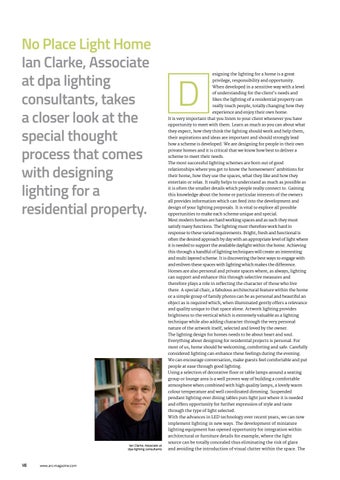No Place Light Home Ian Clarke, Associate at dpa lighting consultants, takes a closer look at the special thought process that comes with designing lighting for a residential property.
D
esigning the lighting for a home is a great privilege, responsibility and opportunity.
When developed in a sensitive way with a level of understanding for the client’s needs and
likes the lighting of a residential property can
really touch people, totally changing how they experience and enjoy their own home.
It is very important that you listen to your client whenever you have
opportunity to meet with them. Learn as much as you can about what they expect, how they think the lighting should work and help them, their aspirations and ideas are important and should strongly lead
how a scheme is developed. We are designing for people in their own private homes and it is critical that we know how best to deliver a scheme to meet their needs.
The most successful lighting schemes are born out of good
relationships where you get to know the homeowners’ ambitions for their home, how they use the spaces, what they like and how they
entertain or relax. It really helps to understand as much as possible as it is often the smaller details which people really connect to. Gaining this knowledge about the home or particular interests of the owners all provides information which can feed into the development and design of your lighting proposals. It is vital to explore all possible opportunities to make each scheme unique and special.
Most modern homes are hard working spaces and as such they must satisfy many functions. The lighting must therefore work hard in
response to these varied requirements. Bright, fresh and functional is
often the desired approach by day with an appropriate level of light where it is needed to support the available daylight within the home. Achieving this through a handful of lighting techniques will create an interesting
and multi layered scheme. It is discovering the best ways to engage with and enliven these spaces with lighting which makes the difference.
Homes are also personal and private spaces where, as always, lighting can support and enhance this through selective measures and
therefore plays a role in reflecting the character of those who live
there. A special chair, a fabulous architectural feature within the home or a simple group of family photos can be as personal and beautiful an
object as is required which, when illuminated gently offers a relevance and quality unique to that space alone. Artwork lighting provides
brightness to the vertical which is extremely valuable as a lighting technique while also adding character through the very personal nature of the artwork itself, selected and loved by the owner.
The lighting design for homes needs to be about heart and soul.
Everything about designing for residential projects is personal. For
most of us, home should be welcoming, comforting and safe. Carefully considered lighting can enhance these feelings during the evening.
We can encourage conversation, make guests feel comfortable and put people at ease through good lighting.
Using a selection of decorative floor or table lamps around a seating group or lounge area is a well proven way of building a comfortable
atmosphere when combined with high quality lamps, a lovely warm colour temperature and well coordinated dimming. Suspended
pendant lighting over dining tables puts light just where it is needed and offers opportunity for further expression of style and taste through the type of light selected.
With the advances in LED technology over recent years, we can now implement lighting in new ways. The development of miniature
lighting equipment has opened opportunity for integration within architectural or furniture details for example, where the light Ian Clarke, Associate at dpa lighting consultants
146
www.arc-magazine.com
source can be totally concealed thus eliminating the risk of glare
and avoiding the introduction of visual clutter within the space. The
